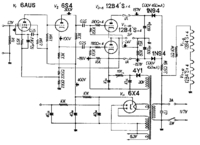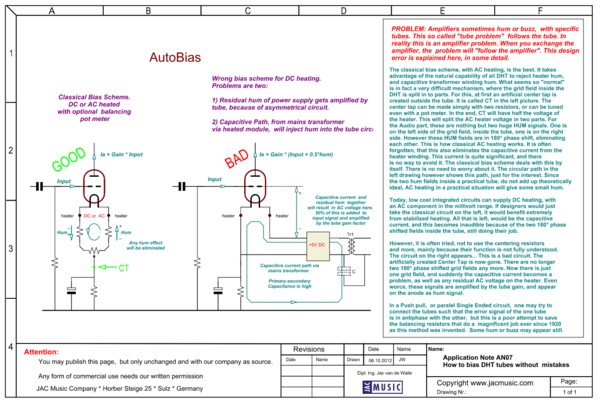Problems with tubes and amplifiers
Contents
- Introduction.
 Consider all possible factors.(You are now here)
Consider all possible factors.(You are now here)- Specific Amplifiers which need special attention
Consider all possible factors.
Not so good conclusions: In case of a particular problem with one tube of a pair or quad, the normal reaction is, to l try this tube in other sockets. This is a logical reaction. Sometimes it can be observed, the issue occurs with one tube of a quad only. Then, the conclusion: it must be the tube, is not far away. This may be right, and it may be wrong. It can happen, that three tubes of a quad will forgive an amplifier problem, and one tube will not. There is no 'must' for a tube, to forgive amplifier problems. We have to look into this further:
There is a hidden expectation, if a brand-A forgives an amplifier problem, and brand-B will not, in such a case, 'B' has better quality. Definition of quality certainly is not described as the ability to withstand abuse. Much to the contrary! High lifetime is only reached under the intended use conditions.
Why tube data sheets exist
The tube datasheet a more than a fact sheet, and not just an advise. In some cases an amplifier can have extremely exceed the maximum allowed peak current for a tube, during the switch on moment. Specially if there is no peak limits specified, that does not mean, a designer can do what he likes, or even ignore it. Values of four times average current can happen, and no tube will like it. . In-rush current with a cold tube should always be minimized by design, and not by trial and error. Especially with KT88 it can happen this causes a spark in the KT88 or the rectifier tube. If that happens, the experiment is repeated by the owner. It will be always that one particular tube, and it is plugged into all the sockets, to see what happens. If he has more amplifiers than one, the tube will also be passed around the other amplifiers, to see what happens. Of course the problem 'follows the tube', but it may well be, he was step by step destroying a good tube! After 100 or so times, this tube has lost some emission, and in addition develops a risk to short the grid to the cathode. The loss of emission, in a push pull stage (typical for KT88) will now cause overload of the other tube of the pair! So after a while it will also have lower emission. Latest by now, the owner gets upset, puts back in his old tubes (that still work good) and will refuse to accept his own behavior as a mistake. Perhaps even so, you need to read back this paragraph again, and say for yourself where the mistake was made, because you also did not recognize the mistake.
The secret schematics

This becomes more difficult as the amplifier manufacturers will never admit a failure with the design. They hide the schematics, but why hide something to be proud of? Can you tell me that? I think there is a special aesthetic in a nicely drawn schematic. Not just showing how it's connected, but also showing what the designer had his mind set on. But no, they say the schematic hold company secrets. Sometimes we force the schematic to be given, or we void guarantee. Then what do we get? A hand made sketch, incomplete, quickly made because we wanted to have it. In case a printed schematic was made, what is the secret about? I ask, because real secrets with tube schematics don't exist. Everything which could be possible be invented with tube schematics, was already invented 75 years ago. I really mean this. If there was a new invention after the OTL design from Julius Futterman, you can let me know, and I promise you, to publish it right here at this place where we are now.
The amplifier information
With this we mean two things: The schematic, and the instructions on how to exchange tubes. Both items are usually kept secret. This is bad service to your customers. Even so this going to be illegal by new European laws. It needs little understanding, the schematic is elementary for self repair.
Why are schematics secret? Please believe me, there was no new schematic invented since the OTL by Julius Futterman in 1942. Really! There are no spies everywhere, who do not really know how to build a tube amplifier. As if they would be anxiously waiting until a good company publishes their schematics, finally knowing how build an amplifier. Really this argument is so silly. It is silly of a professional company because they should know themselves all schematics have already been invented decades before.
However, when I look into a problem in great detail, the situation reverses most of the time, and we find a failure often in the schematic. Then again, we have the discussion like, 'We are doing this since 25 years... and we never had a problem'. Such stupid talk that is! However, it is a fact, when the 5U4G rectifier datasheet says, the maximum capacitor is 33uF, you should not use a higher value. If you have been ignoring that for 25 years, that is not a good sign..
When we suspect an error with the amplifier design, just by saying 'perhaps', we get already refused the schematics.
A good diagnosis however, requires experience. Not tube rolling. My honest judgement is, with amplifier tubes 50% of the tube problems could have EASILY been avoided by better amplifier design, the other 50% less easily, and there is no such thing as an unavoidable problem.
I think manufacturers should make it not so easy for users to do stupid things.
With rectifier tubes that problem percentage is high. Reason is, rectifier tubes schematics are so easy, but choosing the right values is so hard. Yet even with wrong values it initially works. Even when a mistake is obvious, like using a capacitor that is not allowed by the datasheet, even when pointed out, they simply continue making the product that way. I would say in 90% of the cases this is so!
Another risk cause, is mixing tube electronics with semiconductor electronics. Though this is possible, such products were never a break through in the old days. Also I see no new things here, which makes it a break through now suddenly.
EXCHANGING TUBES LIKE EL34, KT88, etc in PUSH PULL AMPLIFIERS
When replacing tubes in such an amplifier, it may damage the new tubes if there is an adjustment procedure for the amplifier, and you don't use this.
To find out if there is a procedure, only ask the manufacturer, and nobody else. If such a procedure exists, and you fail to use it, destruction of the new tubes can result. The tubes can short circuit with a bright blue or white spark from the inside, with or without speaker damage. Even so, not all amplifiers are short circuit proof, and need a repair afterwards.
If the amplifier has hand control of the bias, for each tube, we sometimes see the following mistake is made:
MISTAKE: The user replaces all tubes, switches the amplifier on, and starts to adjust the tubes one by one. When such an amplifier has 6 or even more tubes per channel, you may be too slow adjusting, and one of the tubes will damage before you have a change to adjust it. So at least, you need to set the bias for the tubes to a lower value, before you begin, and use the old tubes for this, to see how it works. Some amplifiers can damage when you set all regulators to minimum, because the internal voltage may become too high. So this is no advice on how to do the settings.
GOOD ADVICE: Please get the official service procedure from the manufacturer, and do not experiment without it. Be cautious when the procedure is secret. This is a red flag! Really an amplifier can be made such that you can exchange tubes yourself, but this seems not always wanted. So any amplifier with a secret schematic, and a secret procedure to exchange tubes, we advise you not to buy such an item.
Heater Voltage.
It is amazing, and sometimes shocking, to see how private people but just as well very well known companies, throw advice of tube manufacturers in the wind. The most common mistake is invent some self-made stories, about why heater voltage is not so important, or should even be another on purpose. Whereas every SINGLE percent deviation will impair lifetime a lot. Also some theories about over heating or under heating, this is for the birds, I do not even read it.
AC Heated amplifiers.
These all have a problem with the mains voltage, because today the quality of the mains voltage is terrible. The electricity companies increase the mains voltage slowly over the years. The higher the mains voltage the more power you use, and the higher the profit. Also, the higher the voltage, the less loss they have in the power lines, which means even more profit. Whatever the reason, they LOVE to increase your mains voltage. So 220V was first unofficially and then officially increased to 230V, and 240V is coming up soon. In my house I had 243 Volts already at several moments, and I had good Hewlett Packard equipment failing from this with blown out protection capacitors, as they were internally only capable of 220V.
The problem is, tube heaters can take maximum 5% voltage tolerance, or 4% for some types. So your good old 220V apparatus, at 243 Volts is overheated by 10% which makes it a real tube destructor. Better set it to 240Volts at the back. If it is too old, and doesn't have that option, buy an adapter transformer from 240 to 220V. Or, exchange tubes 2...3x more often. (Yes that much). These are the only options.
DC coupleds amplifiers
These are genereally very problematic, when the bias of one tube goes up like crazy if the driving tube fails, looses emission, or heats up slower as the 'designer' thought it would. That will lead to damage. We should be aware, the final destiny of every tube is to FAIL. In case this happens, and the amplifier goes up in smoke, please don't say the tube is the cause of this. We have to admit, a tube failure can and will always happen with every tube,if you just use it long enough. If this destroys the amplifier, this is a #1 design mistake.
DC Heated amplifiers unstabilized.
These have the same problem, when the heating is unstabilized.
DC Heated amplifiers stabilized.
the best way is really to have electronically stabilized heaters inside the amplifier. The episode where everybody was shouting that AC heated tubes sound 'better' is forgotten now. Instead of that we hear now similar shouting that 'Current source' heating sounds better. But I wonder what is the sound of a current source like. Main thing is, you keep the heater VOLTAGE constant, regardless the mains voltage.
Application Note AN07. AN07-How-to-bias-DHT-tubes-without-mistakes
